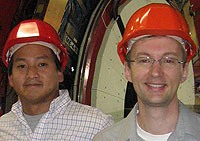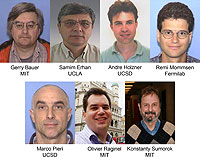Weinberg’s angle
 |
| The original physics idea behind today’s measurement came when a physicist was driving a car like this one. So much for the claim that physicists aren’t cool...
|
One bright day in 1967, future Nobelist Steven Weinberg was driving to work in his brand new, bright red Camaro convertible when he had an epiphany. He understood the mechanism that broke the symmetry between the weak nuclear force, which is responsible for some forms of radioactivity, and the electromagnetic force, which holds atoms together, explains light, magnets, lightning and static cling.
His 1967 paper describing this insight also included some ideas that had been proposed in an earlier paper by Sheldon Glashow. One such idea was weak neutral currents. A neutral current occurs when an incoming particle shoots a neutral particle at another incoming particle, causing both of them to scatter. A weak neutral current is when this scattering is caused by the weak nuclear force. Energy is exchanged, but the electrical charge isn't. Neutral currents were discovered in 1973 by the Gargamelle collaboration at CERN. Later experiments isolated this neutral particle involved in the weak force. It is called the Z boson and was discovered in 1983 at CERN. For his contributions to electroweak unification, Weinberg was awarded the 1979 Nobel Prize, along with Sheldon Glashow and Abdus Salam.
The Weinberg angle, which is recently more often called the weak mixing angle, is a mathematical component of the theory integrating the weak and electromagnetic forces. Essentially, it connects the photon (electromagnetism) and the Z boson (the weak force). While the weak mixing angle has been measured before, it is important to study it again at the LHC to verify there are no surprises. CMS scientists looked at events in which a muon and antimuon were created. This required a quark from one beam to annihilate with an antiquark from the other, creating a photon or Z boson. This particle then decayed into the muon/antimuon pair. This is the first study of this kind using muons at a hadron collider.
To measure the weak mixing angle, CMS scientists determined the orientation of the outgoing muon as compared to the direction of the incoming quark. However, unlike the Tevatron, in which one of the beams consisted of antiprotons, the LHC collides beams of protons. Thus, it is not possible to know which proton contained the quark and which the antiquark. CMS scientists used their knowledge of how the quarks share the parent proton’s momentum to determine which proton was most likely to have carried the quark. Using this methodology, they were able to measure the weak mixing angle to a precision of one percent and found it was in good agreement with expectations. The impressive precision of these Standard Model measurements can only increase our confidence when we encounter something unexpected.
—Don Lincoln
 |
|
Nhan Tran and Andrei Gritsan from The Johns Hopkins University made important contributions to this analysis.
|
 |
|
U.S. physicists play a substantial role in CMS central data acquisition.
|
|